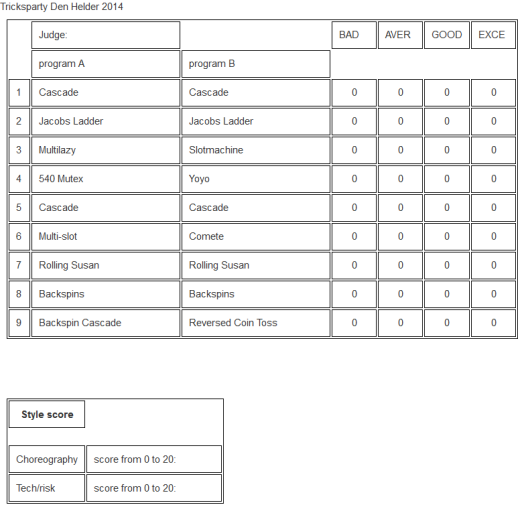Judging: Ballet

Here you can see an example competition score sheet like the judges will have. It can be different depending on the organizer, but the idea is always the same. You can see the name and year for this competition. The pilots name is top of the page, but got cut off in this example. Then there is a spot where the judge can fill in his name (or number). We need to know afterwards who's scoresheet this is, just in case something goes wrong or needs some clearing out. Individual scores from judges are never shown in public. This is to prevent judges being asked about scores and starting endless and useless discutions.
You can see two lists with tricks. Just before his routine starts, a pilot must tell the field director wich list he will fly (A or B). The pilot can also choose to change up to two tricks from that list. The field director will then inform the judges about this. They take note of the names of the replacement tricks, so that judging is correct.
On the right you see 4 columns with the possible scores for each trick. It's not a rule, but it helps to note your score in 3 possible ways: left, center or right in the apropriate column. When comparing scores afterwards, it's easy to remember where you scored a trick. You can give "GOOD" but think that is in the low area, close to average. Or it could be "GOOD" and only a small amount of this or that away from excellent. So again, it's not a rule, you are good in just marking in the middle. It's just a thing that comes with experience ;-)
You have to be very concentrated to follow where the pilot is in his list. As no IN or OUT are called and the music is rather loud (that's good for the show and pilot), you need to be alert at what the pilot is doing. Write down your score immediately and look at the kite, the next trick may be very close behind the other one! When you miss a trick, don't panic! When the ballet is done you have two other judges who you can consult and take over their score for the missed trick. Most pilots ask the field director to call the tricks when they ask for it. The field director is always close to the pilot, so a short "next?" or "next!" will always be a sign that the next trick in line is coming up. Like all of this, it's something that improves when you have done a couple of competitions.
On the bottom of the scoresheet you see the spot for the "style scores". Once the ballet is done (they do say OUT or raise their hand or something like that) or run over time (the fied director will tell the judges), you can go over the entire ballet in your mind. Then give a score from 0 to 20 for choreography. This is mostly if the ballet was pleasing to the eye, close to the music and had a general feeling of "art". It's a personal thing, so scores can be very different from one judge to another. Go for your own feeling! The last score to give is that Technical/Risk thing. Also from 0 to 20. Here you give higher marks if the pilot shows good technical skills and did most of his ballet with a certain 'risk'. The difference is here that a good pilot will fly his tricks in the middle of the wind window, a lesser pilot will play safe and fly the tricks closer to the window edge. This is also a score for what the pilot does between his list-tricks, does he do other difficult tricks or flies only straight corners and lines? Again, follow your feeling about what the pilot showed with the kite. Scores here should normally be closer together and can be very different from the choreo-score.
How to judges the tricks? It's about the same as with Imposed Tricks, but here you only have to put the trick in one of four possible marks. After a while you'll know soon where to put down your mark, at the start of your judging carreer, you may use a rule of thumb like this:
- I have not seen the trick, there was an attempt or not, but the kite crashed or whatever >>> points from 0 up to 2 >>> BAD
- I have seen the trick, but IN and/or OUT were not good at all, the kite wasn't flat in the rotations, or was not stable at all or not held long enough in the position >> points from 3 up to 5 >>> AVERAGE
- I have seen the trick, IN and OUT were good enough, there were 3 rotations and rather flat, held for enough seconds... >> points from 6 up to 8 >>>> GOOD
- Yeah man, IN and OUT couldn't be better, you had 5 rotations or held for more than 2 seconds very stable >>> points from 9 (I have never seen 10) >>> EXCELLENT
in short: all above 8 is EXCELLENT.
The idea behind this is that you still judge with points from 0 to 10, so judging is the same for each and every trick you see during a competition. It's what you mark down that changes a bit. A judge doesn't have to care about the difficulty groups or if there is a second attempt at the imposed tricks. Just scoring up to 10 and that's it.
That said, there is a thing inside ballets that is harder to learn: seeing if there is an attempt to do a trick or not. In a ballet there is no such thing as a second try. If you fail, then bad luck and move on, pilot! No, most of them try to do the trick again (sometimes up to 4 tries!) and that is not good for their choreography and they loose sync with the music. There was a time where the judges used to consult after each ballet to see if they missed "second attempts" and to see what other judges scored for this and that. Over the years, we did find out that most pilots didn't liked the idea of consulting, and correctly so. Since a couple of years we don't see each others scoresheets unless there is good reason for that (missed a trick or such). What we do sometimes when there is/are new judges is consulting after the first pilot only. To see if marks are put down in the right place and somewhat at the same height as the others. Also, a shadow judge may consult all judges after each pilot, he/she is learning and that's a good way to learn when you can remember very well what you have seen. If pilot number 5 is flying I can hardly remember all the tricks pilot number one did.
That concludes all there is to know about judging Tricksparty! If you have more questions, use the contact page on this website or ask at a competition day. We will put more pages in here with practice material for would-be judges and all who wants to have a go at it. There will also be a more technical page about how the scores add up into the final total, although that is not of much concern for judges, it's good to know these things, both pilots and judges.
